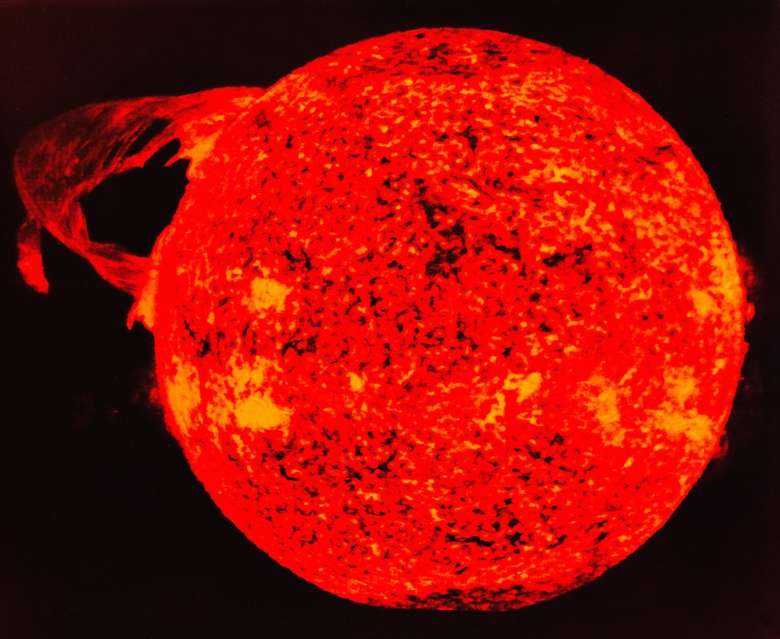The Effects Of Solar Flares On Technology
The sun comes up every day, looking the same as it did the day before. But behind the constant yellow glow is a roiling, writhing mass of energetic particles that sometimes sends bursts of energy and particles away from its surface. Sometimes solar flares are accompanied by giant clouds of energetic particles called coronal mass ejections, or CMEs. Flares and CMEs pose very little danger to people, but they can have a big impact on technology.
Solar Flares and Satellites
Solar Flares and Satellites
Solar flares are bursts of radiation — radio waves, light, ultraviolet, x-ray and gamma ray emissions — that shoot out from the sun like a flash from a giant searchlight. If that flash reaches the Earth, all that extra energy can cause problems. Radio, light, infrared and microwaves don't contain enough energy to do damage, but some ultraviolet, x-rays and gamma rays can pierce the shielding on satellites and rip through the electronics. They don't produce any visible damage, but the computer chips on a satellite can suffer enough radiation damage that the microscopic circuits can be temporarily or permanently damaged. Satellites have shielded radiation-hardened electronics, so ordinary solar flares won't cause many problems, but extremely large flares — the ones that appear to come every 500 years or so — could cause severe damage.
This could affect Global Positioning System signals, television and radio transmissions and telecommunications.
Solar Flares and the Atmosphere
Solar Flares and the Atmosphere
Solar flares have been around far longer than people have been around, and for most of human history no one had any idea there even was such a thing — so solar flares don't mess directly with people. The primary reason is that the upper atmosphere of the Earth protects the surface. The high-energy radiation from a solar flare hits the atoms and molecules in the upper atmosphere and gets absorbed.
When the atmosphere absorbs that extra energy, it heats up a bit — not much but enough to expand a little. This means that satellites orbiting just above the edge of the atmosphere aren't above the edge anymore, so they run into more air molecules. That slows them down and shortens their lifetimes. The absorbed energy also messes with radio transmissions on the Earth — making some travel further and blocking others completely.
CMEs
CMEs
Not every solar flare is accompanied by a CME, and not every CME is big and dangerous. But when there is a big, dangerous CME headed for Earth, once again the surface is protected. The Earth's magnetic field traps the charged particles, turning them so they bounce back and forth in the magnetic field lines before running into enough atoms and molecules in the atmosphere to slow them down.
Those flowing charged particles make an electrical current above the Earth, creating beautiful aurorae where the Earth's magnetic field comes close to the surface at the poles. The current above the Earth also creates a mirror current on the surface of the Earth. In most places, the mirror current dies out very quickly, because rocks and soil don't conduct electricity very well. Where there are long wires, though, the current can build up. That's where the damage can come from.
Damage from CMEs
Damage from CMEs
CMEs trapped in the Earth's magnetic field are so far away that they create just a tiny influence on current flow on the Earth. Where there are wires that stretch for hundreds of miles — as in power distribution networks — that little bit of added current builds up, mile after mile. This buildup can knock out transformers and generators. CME-induced currents can be kind of like a lightning strike — sending a rapid surge into your house. That surge can damage or destroy any electronic device that's plugged into a socket.
The current only builds up on those long wires, though, so if you unplug your devices when a large CME is on the way, they'll be fine. Don't worry too much; it's only the largest of CMEs that create any measurable current surge, and they come with warnings of somewhere between half a day and a few days. The big concern here is for the safety of power transmission and generation equipment.
Cite This Article
MLA
Gaughan, Richard. "The Effects Of Solar Flares On Technology" sciencing.com, https://www.sciencing.com/effects-solar-flares-technology-20402/. 24 April 2017.
APA
Gaughan, Richard. (2017, April 24). The Effects Of Solar Flares On Technology. sciencing.com. Retrieved from https://www.sciencing.com/effects-solar-flares-technology-20402/
Chicago
Gaughan, Richard. The Effects Of Solar Flares On Technology last modified March 24, 2022. https://www.sciencing.com/effects-solar-flares-technology-20402/
